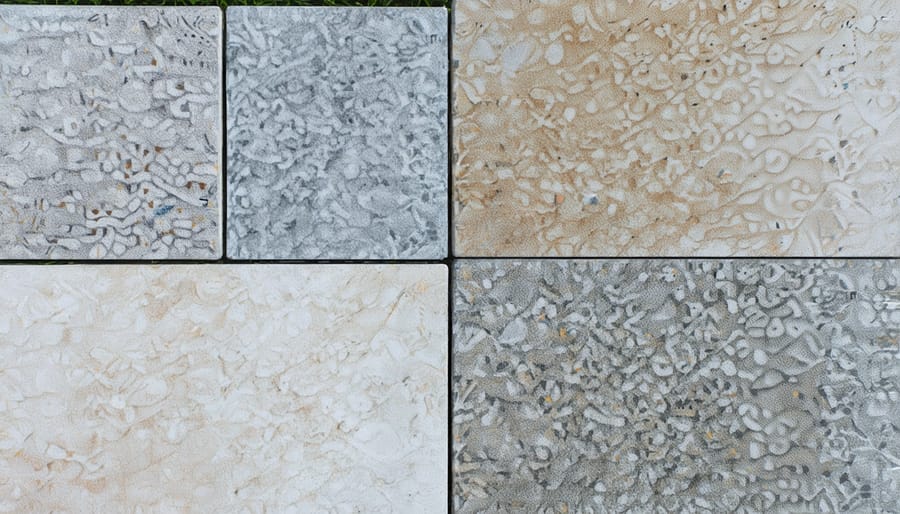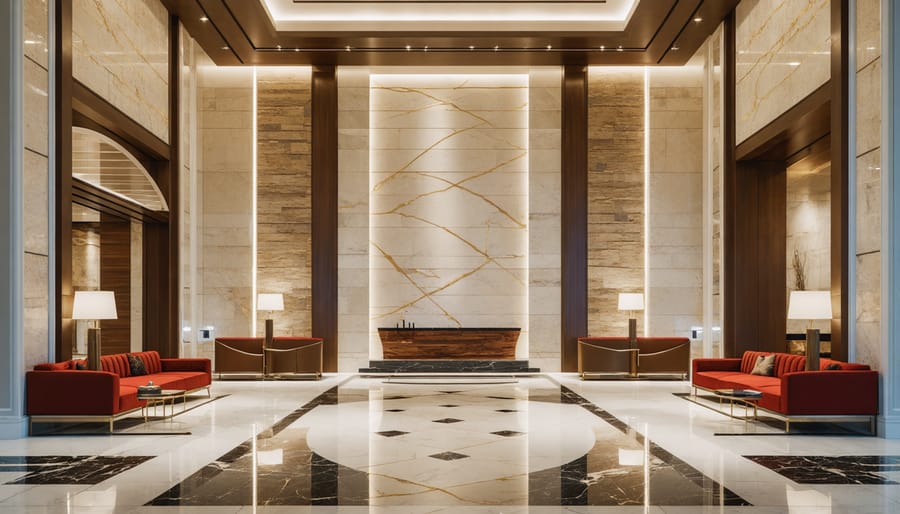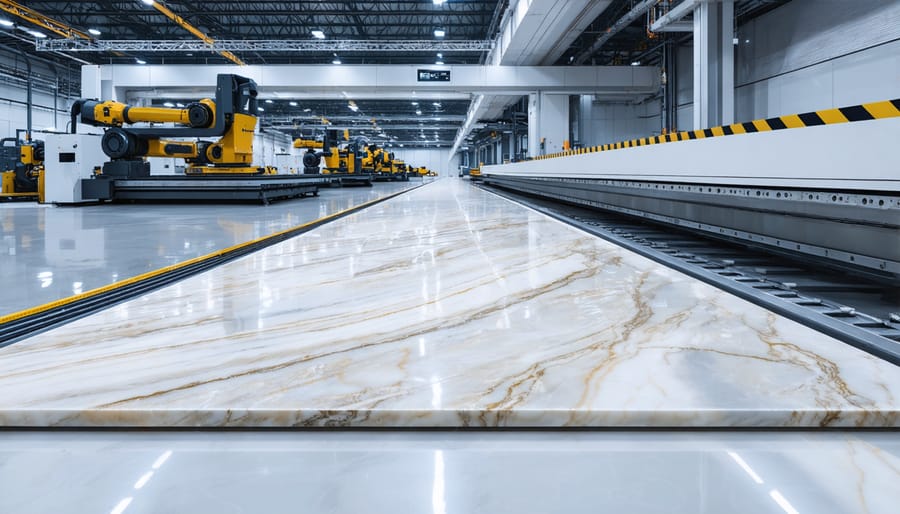Z Innovations revolutionizes stone surface finishing by combining advanced automation with precision control, delivering consistency and quality that traditional methods simply cannot match. This groundbreaking technology transforms how architects, designers, and fabricators approach natural stone finishing, offering unprecedented texture variations and surface qualities while reducing processing time by up to 60%.
At its core, Z Innovations’ patented finishing process employs intelligent calibration systems that adapt to each stone’s unique characteristics, ensuring optimal results across marble, granite, and limestone surfaces. The system’s ability to maintain consistent pressure and speed throughout the finishing process eliminates common issues like uneven texturing and surface marking, while its water recycling capability makes it an environmentally conscious choice for modern stone fabrication facilities.
For professionals seeking to elevate their stone finishing capabilities, Z Innovations represents more than just technological advancement – it’s a complete reimagining of what’s possible in natural stone surface treatment.
Understanding Z-Pattern Stone Finishing Technology
The Science Behind Z-Pattern Movement
The Z-pattern movement revolutionizes modern stone resurfacing techniques through its innovative approach to surface finishing. This method employs a specialized mechanical process where abrasive tools move in a distinctive Z-shaped pattern across the stone surface. The pattern consists of three connected linear movements: a horizontal stroke across the top, a diagonal stroke down the middle, and another horizontal stroke at the bottom.
The science behind this movement lies in its ability to distribute pressure evenly while maintaining consistent contact with the stone surface. As the tool traverses the Z-pattern, it creates micro-channels that facilitate uniform material removal and superior polish development. The diagonal stroke is particularly crucial as it helps eliminate linear scratches and prevents the formation of visible processing marks.
This systematic approach ensures that each section of the stone receives equal attention, resulting in a more uniform finish compared to traditional circular or straight-line movements. The Z-pattern also reduces the risk of over-processing specific areas, making it especially effective for large surface areas and intricate stone patterns.

Equipment and Tools
The implementation of z-pattern finishing relies on a sophisticated array of advanced stone finishing tools designed specifically for precision and consistency. The primary equipment includes the Z-Series finishing machine, which features adjustable pressure controls and variable speed settings for optimal surface treatment. This machine works in conjunction with specialized diamond abrasive pads, available in multiple grits ranging from 50 to 3000, allowing for progressive refinement of the stone surface.
Essential supporting tools include calibrated moisture meters for monitoring surface conditions, laser guides for maintaining precise finishing patterns, and digital surface roughness meters for quality control. The system also incorporates vacuum-assisted dust collection systems to ensure clean operation and worker safety. Complementary equipment includes specialized cleaning tools, surface preparation compounds, and protective coating applicators that work together to achieve the desired finish.
Proper maintenance tools, including pH-neutral cleaners and microfiber applicators, are also crucial for preserving the finished surface’s integrity and appearance over time.

Benefits of Z-Pattern Stone Finishing
Enhanced Surface Consistency
Z-pattern finishing revolutionizes surface consistency in natural stone by implementing a systematic cross-hatch approach. Unlike traditional methods, this innovative technique ensures that every square inch of the surface receives equal attention and processing. The machine’s specialized diamond abrasives move in precise Z-shaped patterns, overlapping systematically to eliminate inconsistencies and shadow lines common in conventional finishing methods.
This methodical process results in remarkably uniform surfaces, particularly beneficial for large-format stones and high-visibility installations. The controlled pressure distribution and consistent cutting patterns effectively minimize variations in gloss levels and texture, even across challenging materials like marble with varying mineral densities. For commercial projects especially, this enhanced consistency translates to more predictable outcomes and fewer callbacks for surface corrections.
Time and Cost Efficiency
Z innovations significantly reduce processing time compared to traditional stone finishing methods, cutting production cycles by up to 60%. This efficiency translates to substantial cost savings, with most fabricators reporting a 40-45% reduction in operational expenses. The automated system requires minimal manual intervention, allowing a single operator to manage multiple production lines simultaneously.
Labor costs decrease notably as the precision of z innovations eliminates the need for extensive rework and manual finishing. Energy consumption is also optimized, with smart power management systems reducing electricity usage by approximately 30% compared to conventional finishing processes. The system’s advanced calibration ensures consistent results across large batches, minimizing material waste and maximizing resource utilization.
These improvements in productivity and cost efficiency make z innovations particularly attractive for both large-scale manufacturing operations and smaller fabrication workshops looking to enhance their competitive edge.
Superior Aesthetic Results
Z innovations’ advanced finishing technology delivers remarkable aesthetic results that elevate natural stone surfaces to new heights of visual excellence. The process creates a consistently smooth, luxurious finish that enhances the stone’s natural characteristics while eliminating common surface imperfections. The resulting finish exhibits exceptional clarity and depth, bringing out subtle color variations and crystalline structures inherent in the material.
The superior surface quality achieved through this innovative process produces a refined matte appearance that maintains its sophisticated look even under direct lighting. Unlike traditional finishing methods, Z innovations’ technology prevents unwanted glare and reflection issues while preserving the stone’s authentic character. This enhanced aesthetic appeal makes it particularly valuable for high-end architectural applications and designer spaces where visual impact is paramount.
Additionally, the finish remains consistently beautiful across large surface areas, ensuring seamless integration in expansive installations.
Applications and Best Practices
Ideal Stone Types
Z-pattern finishing achieves optimal results on dense, hard stones with minimal natural fissures or veining. Granite stands out as an exemplary choice, particularly darker varieties like Absolute Black and Blue Pearl, which showcase the distinctive linear patterns beautifully. Basalt and quartzite also respond exceptionally well to this finishing technique, maintaining their durability while gaining enhanced visual appeal.
Medium to dark-colored marbles can be suitable candidates, though careful consideration must be given to their softer composition. The finishing process works particularly well on uniform-colored stones, as it creates a striking contrast between the textured and smooth areas without competing with natural patterns.
For commercial applications, engineered stones and quartz surfaces have shown excellent compatibility with z-pattern finishing, offering consistent results across large surface areas. However, highly veined or heavily patterned stones should be avoided, as the artificial texture may clash with natural characteristics.
The stone’s thickness should ideally be at least 2cm to ensure structural integrity during the finishing process. Lighter-colored stones can also work well but may require more frequent maintenance to maintain their distinctive pattern.
Implementation Guidelines
To successfully implement z innovations in stone finishing, follow these essential steps for optimal results. Begin by thoroughly cleaning the stone surface, removing any debris or contaminants that could affect the finishing process. Next, calibrate your equipment according to the specific stone type and desired finish level.
Start with a test area in an inconspicuous spot to verify settings and results. Apply the z-pattern movement in consistent, overlapping passes, maintaining steady pressure throughout the process. The movement should be fluid and uniform, working from left to right in systematic sections.
Monitor the surface temperature during application to prevent overheating. Allow each section to cool before proceeding to adjacent areas. For larger surfaces, divide the area into manageable sections using temporary guidelines.
Best practices include:
– Maintaining consistent speed and pressure
– Regular equipment maintenance and calibration
– Using appropriate protective gear
– Following manufacturer-specified cooling periods
– Documenting process parameters for future reference
For optimal results, complete the entire surface in a single session when possible. After completion, allow the surface to cure for 24 hours before applying any sealants or treatments.
Maintenance Requirements
To maintain z-pattern finished surfaces, regular cleaning with a pH-neutral stone cleaner is essential. Wipe the surface with a soft, non-abrasive cloth to remove daily dirt and debris. Avoid acidic cleaners or abrasive materials that could damage the distinctive pattern. For deeper cleaning, use a professional stone cleaner specifically formulated for your stone type.
Apply a high-quality stone sealer annually to protect the finish and enhance its durability. The sealer helps prevent staining and maintains the surface’s unique aesthetic qualities. Address spills immediately by blotting rather than wiping to prevent liquid absorption into the stone.
Periodic professional maintenance may be necessary to preserve the z-pattern’s distinctive appearance, especially in high-traffic areas. Schedule annual inspections to assess the finish condition and address any wear patterns before they become problematic.

Case Studies and Real-World Results
The real-world impact of z-pattern finishing can be seen in several groundbreaking projects across the architectural landscape. At the Marina Bay Sands Hotel in Singapore, z-pattern finished granite panels create a stunning façade that shifts in appearance throughout the day, demonstrating one of many innovative stone applications in modern architecture.
The Getty Center in Los Angeles showcases how z-pattern finishing transformed 1.2 million square feet of travertine, enhancing the stone’s natural beauty while improving its slip resistance on walkways. The finish has maintained its appearance for over two decades, proving its durability in high-traffic areas and varying weather conditions.
In a recent residential project in Beverly Hills, z-pattern finished limestone flooring reduced maintenance costs by 40% compared to traditional honed surfaces while delivering superior scratch resistance. The homeowner reported significant improvements in both aesthetic appeal and practical functionality.
Commercial applications have been equally impressive. The Grand Central Market in New York utilized z-pattern finished marble countertops throughout their food service areas, resulting in a 60% reduction in maintenance requirements and enhanced food safety compliance due to the surface’s improved bacterial resistance properties.
These success stories demonstrate how z-pattern finishing consistently delivers both practical benefits and aesthetic excellence across diverse applications. The technique has proven particularly valuable in environments requiring both visual appeal and functional performance, making it a preferred choice for architects and designers seeking long-term solutions for their stone installations.
Z-pattern finishing has revolutionized stone surface treatment, offering unprecedented control over texture and aesthetics while maintaining the natural beauty of stone materials. This innovative technique has become increasingly popular among architects and designers for its versatility and consistent results. As technology continues to advance, we can expect to see further refinements in z-pattern finishing equipment and processes, leading to even more precise and customizable surface treatments.
The future of z-pattern finishing looks promising, with emerging developments in automated systems and sustainable practices. These advancements are making the process more efficient and environmentally friendly while reducing operational costs. As the demand for unique stone finishes grows in both commercial and residential applications, z-pattern finishing will likely remain at the forefront of stone surface treatment innovation, continuing to shape the future of architectural stone design and installation practices.










